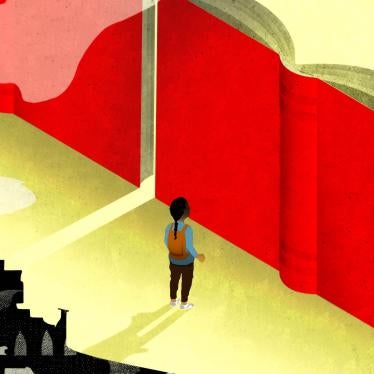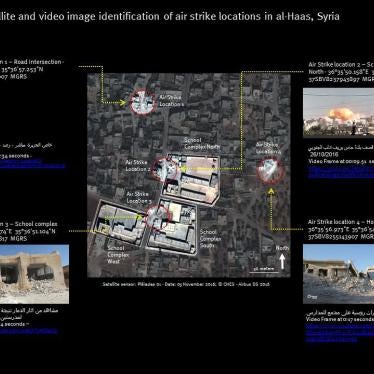(Beirut) – Syrian-Russian airstrikes and artillery attacks on June 14, 2017, in a town in the southern Daraa governorate killed 10 civilians in and near a school, Human Rights Watch said today. Residents said they were not aware of any military targets in the vicinity of the attacks.
One of the airstrikes hit the courtyard of Martyr Kiwan middle school in the town of Tafas, killing eight people, including a child, most of them members of a family who had been displaced from another town and were taking shelter there, witnesses said. Artillery attacks roughly an hour earlier on the same day killed two other civilians, including one child, near the school. At least five people were wounded.
“A sign at the entrance of the middle school in Tafas says, ‘Keep the school clean,’ but the floor was smeared with the blood of a whole family on June 14,” said Bill Van Esveld, senior children’s rights researcher at Human Rights Watch. “As long as no one is held responsible for such repeated unlawful attacks, it’s likely they will continue.”
Witnesses said that to their knowledge no members of non-state armed groups fighting the Syrian government were killed or injured in the attacks, and that they did not know of any military objects in the vicinity of the attacks. A local resident said that anti-government armed groups known as Fajr al-Islam and al-Mutaz Bellah are present in Tafas, 13 kilometers north of the city of Daraa, but that neither had any presence in or near the school.
Human Rights Watch contacted witnesses and residents in Tafas by phone and WhatsApp, as well as a relative of the displaced family that had been sheltering there. Some of the names of those interviewed are withheld for their protection. Human Rights Watch also reviewed photographs and videos the witnesses shared. Tafas hospital, where most of the victims were transferred, provided a short report describing the victims’ injuries. Syrian government ground forces are located about five kilometers southeast of Tafas.
Human Rights Watch is not aware that the Syrian or Russian authorities made any statements about the attacks.
The Martyr Kiwan school had 300 to 400 students before the 2011 uprising, and a similar number subsequently, as some children from Tafas had fled but others who had been displaced from other towns were enrolled there, said one Tafas resident. The school was on summer vacation on June 14, which may have limited the number of casualties. The school had previously been damaged by an airstrike in November 2016 that did not cause any casualties, and had continued to operate even though some displaced families were living there. Another resident who lives nearby said that middle school staff told him they plan to teach students in two shifts in the building that was not damaged until the damaged building can be repaired.
Syrian opposition groups captured Tafas in August 2013. All the witnesses Human Rights Watch spoke to said that there were no fighters or other military objects in or near the areas that were attacked on June 14. “The rebels are far from the town, on agricultural lands and in old bases,” said Abu Wesal, a civil defense worker who responded to the attacks. The opposition Free Syrian Army stated that it launched rocket and artillery attacks against Syrian army vehicles at a checkpoint in Khirbet Ghazala, about 15 kilometers east of Tafas, on June 14.
Abu Wesal shared photographs he took of the impact crater in the school courtyard, and of the remnants of the bomb used in that airstrike, but it is not possible to positively identify a specific type. However, given the close proximity to the weapons’ impact, the bomb created significant blast, fragmentation, and thermal effects, which are evident on the bodies of the victims. Both Abu Wesal and another civil defense worker who responded to the attacks said that all the bodies and wounded they evacuated were civilians, and that there was no military object at the school. No weapons or military uniforms are visible in any of the videos and photographs of the attack’s aftermath that Human Rights Watch reviewed.
Witnesses said they could not see the aircraft that dropped the bombs. A fixed-wing aircraft is briefly visible in a video posted online by Shahid, a local media organization, which the group described as footage of the first airstrike on Tafas. Two subsequent airstrikes hit the north and east of Tafas, causing minor injuries, a second civil defense worker said.
The United Nations children’s agency, UNICEF, reported at least 87 attacks on schools or educational staff in Syria in 2016, which killed 255 children in or near schools. The Syrian Human Rights Committee reported 132 attacks against “educational institutes” in 2016, including 113 by Syrian-Russian airstrikes. A Syrian nongovernmental humanitarian group, the Assistance Coordination Unit, found that 27 percent of the 3,373 schools it assessed in November and December 2016 in 90 subdistricts in Syria had been damaged due to the conflict.
According to the UN, 1 in 3 children in Syria are out of school and 1 in 3 schools are not operating because they have been damaged, destroyed, used by military forces, or used to shelter displaced civilians.
“The joint Syrian-Russian military operation in Syria has repeatedly demonstrated contempt for civilian lives and for the schools, which represent a better future for the country,” Van Esveld said. “The attacks on Tafas appear unlawful, and the victims deserve justice.”
The June 14 attacks in Tafas
At around noon on June 14, 2017, an artillery attack killed Hiba al-Hasan, a 12-year-old girl, and Mohamad al-Salkhadi, who was selling vegetables, near al-Omari square, a residential area in the middle of town, Abu Wesal and another civil defense worker in Tafas who responded to the attacks told Human Rights Watch separately. Other artillery attacks hit areas in Tafas to the north and west at around the same time but without casualties, and attacks continued later in the day, the men said. Abu Wesal said the artillery attacks originated from the direction of areas controlled by Syrian government forces near Tafas: Tal al-Khedr and Dara’a al-Panorama. Tafas has been subjected to repeated artillery attacks from government-held areas, witnesses said.
Beginning at around 1 p.m., a fixed-wing jet aircraft dropped four bombs in short succession on Tafas, witnesses said. The first airstrike hit an open area immediately behind the Kiwan middle school, about 300 meters south of the square hit by the earlier artillery strike. Another civil defense worker said he arrived at the site of the explosion within a few minutes, and that a second airstrike hit the school’s front courtyard shortly thereafter. “I saw the [second] bomb hit the school, because I was very close,” he said. “Me and my team went inside the school.” Human Rights Watch saw a video that the civil defense worker said he filmed at the time showing at least five bodies, blood, and body parts in the school entrance.
Abu Wesal also arrived at the school shortly after the second attack, “about three minutes after the first one, just enough time for the plane to circle around.” Among the victims whose bodies he removed was that of his cousin, Ahmad Naji Kiwan, whose home was next to the school.
It was the first time I’d seen something like that – the remains were splattered all over. There were six bodies, amputated heads, amputated hands, amputated legs, not one was left intact. We tried to look for survivors and heard children screaming. The only two survivors we found are the boy [Bara’a al-Masri] and a girl. They were […] stuck under mattresses and furniture. I swear, to this moment, the smell of blood and remains is stuck on the metal. The [bomb], when it fell, tore down the door, the metallic front gate of the school. We found one body with part of the door having pierced him from the chest onto his back. Something indescribable.
The other seven people killed and wounded at the school were among roughly 15 members of an extended family who had been sheltering there since Syrian forces captured their hometown of Ataman, about 10 kilometers away, in February 2016, said a resident who lives near the school. Witnesses and Syrian rights groups identified the family members killed as Yasmin al-Masri, a 13-year-old girl, and her relatives Rami, Mohamad Ahmad, Mohamad Ayed, Ahmad, Mahmud, and Mahmud’s wife, Basma al-Hari, 31. Al-Hari died while in surgery due to shrapnel wounds in the head, chest, and stomach, according to a written statement from Tafas hospital.
The hospital statement said it had received the bodies of seven people who were killed in the attack, as well as al-Hari, who died in surgery, and four other al-Masri family members who were wounded: Bara’a Mohamad al-Masri, 3, who had abdominal wounds and a ruptured leg artery; another boy, a girl, and a woman, 55, who had abdominal wounds and was transferred to Jordan. A video uploaded to YouTube on June 24 by Orient News shows a boy identified as Bara’a al-Masri, and a doctor who describes performing surgery on him.
The aircraft conducted two other airstrikes shortly after hitting the school, witnesses said. The third strike wounded two children when it hit a former military barracks about 2.5 kilometers east of the school that is being used as shelter for displaced families from the towns of Sheikh Maskin, Ebtah, Garfah, and Ataman, Abu Wesal said. The fourth airstrike hit land next to a former cigarette warehouse which also shelters displaced people on the edge of Tafas without causing casualties.
Another resident who lives near Tafas told Human Rights Watch that he visited the school the day following the attack on behalf of a children’s organization, and that he also met Bara’a al-Masri in the hospital: “He had no one anymore. No mother. No father. Only his uncle, who was devastated. I went to visit him the next day as well, and offered some help.” The boy was discharged from hospital five days later. A family member said that the boy had been transferred to a hospital in Jordan, with another relative.










